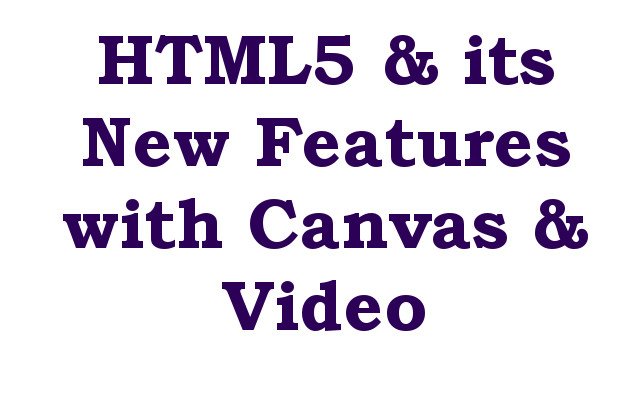In this article we want to talk about HTML5 & its New Features with Canvas & Video, so HTML5 is the latest version of Hypertext Markup Language and it was introduced in 2014. it comes with different new features that enhance capabilities of web developers to create dynamic and interactive websites. two of these features are Canvas and Video which have transformed the way web content is presented and consumed.
Canvas is an HTML5 element that enables developers to create graphics and animations on web page using JavaScript. It provides drawing surface that can be used to render dynamic images, animations, charts, graphs and games. canvas element works by defining rectangle on web page where content can be displayed.
One of the most significant advantages of Canvas is that it provides high degree of control over rendering process. Developers can manipulate individual pixels and create custom shapes and gradients and it makes it good choice for creating highly interactive and responsive user interfaces. Canvas can also be used to create complex animations that run smoothly on all devices, including mobile phones and tablets.
Another notable feature of HTML5 is its builtin support for video. prior to HTML5 displaying video on website required third party plugins such as Adobe Flash or QuickTime. these plugins often caused security vulnerabilities and compatibility issues and makes it difficult to deliver consistent video experiences across different browsers and devices.
with HTML5 developers can embed video directly into web page using video element. video element provides standardized way to play videos without the need for additional plugins. it also supports different codecs and formats, including MP4, WebM and Ogg and makes it easier to deliver video content to broader audience.
HTML5 video also provides advanced features such as subtitles and closed captions, allowing developers to create more accessible and inclusive video content. also HTML5 video supports adaptive streaming, which enables video content to be delivered at the highest quality possible while avoiding buffering and playback issues.
In result we can say that HTML5 has brought about significant improvements in web development with its Canvas and Video features. Canvas provides powerful tool for creating dynamic and interactive graphics and animations, while Video simplifies process of delivering high quality video content across different devices and platforms. with these features web developers can create richer and more engaging user experiences and it makes it web more immersive and exciting place for all, now let’s create our example on these two elements
This is simple example of using Canvas to create basic animation:
|
1 2 3 4 5 6 7 8 9 10 11 12 13 14 15 16 17 18 19 20 21 22 23 24 25 26 27 28 29 30 31 |
<!DOCTYPE html> <html> <head> <title>Canvas Animation Example</title> </head> <body> <canvas id="myCanvas" width="400" height="400"></canvas> <script> var canvas = document.getElementById("myCanvas"); var ctx = canvas.getContext("2d"); var x = canvas.width/2; var y = canvas.height/2; var dx = 2; var dy = -2; function draw() { ctx.clearRect(0, 0, canvas.width, canvas.height); ctx.beginPath(); ctx.arc(x, y, 20, 0, Math.PI*2); ctx.fillStyle = "#0095DD"; ctx.fill(); ctx.closePath(); x += dx; y += dy; } setInterval(draw, 10); </script> </body> </html> |
In this example canvas element is created with the ID myCanvas and given width and height. JavaScript code then defines function called draw that clears the canvas, draws circle at center of the canvas and moves circle in diagonal direction. setInterval function is used to call the draw function every 10 milliseconds and it creates smooth animation.
Video Example:
|
1 2 3 4 5 6 7 8 9 10 11 12 13 |
<!DOCTYPE html> <html> <head> <title>HTML5 Video Example</title> </head> <body> <video controls> <source src="example.mp4" type="video/mp4"> <source src="example.webm" type="video/webm"> Your browser does not support the video tag. </video> </body> </html> |
In this example video element is created with controls attribute, which adds playback controls (such as play/pause, volume and fullscreen) to the video. source elements specify video file’s location and format and type attribute tells the browser which codec to use. if browser does not support the video tag or the specified codecs, the text Your browser does not support the video tag is displayed instead.
Learn More on TKinter
- Python GUI Programming: Create Desktop Applications with Python
- Create GUI Applications with Python & TKinter
- Python TKinter Layout Management
- How to Create Label in TKinter
- How to Create Buttin in Python TKinter
- Build Music Player in Python TKinter
- Python GUI Programming with TKinter
- TKinter VS PyQt, Which one is Good
- Creating Custom Widgets in TKinter
